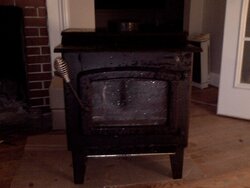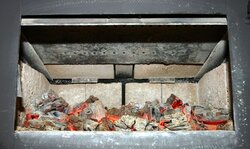I recently talked a friend into buying a stove from Craig's list. Thanks to everybody's help we identified it as a Century CDW 244, or maybe an early version of that stove.
http://www.vermontcastings.com/content/products/productdetails.cfm?id=323
Now, I'm having trouble getting it to burn.
I installed it in her fireplace. I put 14 feet of 6 inch single wall pipe on it and I can't get it to draft.
When we picked it up I took the firebrick out. I thought they all were the same size but apparently not. Now I can't get them back in correctly. I also can't find a diagram online. I think I may have covered up the primary air intake with a brick.
Could someone please post a picture of how the brick are supposed to go in the stove?
Also, could you please tell me where the primary air is on the stove? On my Summit there are holes in the bottom front of the fire box. On this stove I dont see any. Also where the does the air enter the stove? This stove sat in an out building for a few years before we bought it and I'm afraid there might be some sort of nest clogging the intake up and I would like to inspect it and clean it out if possible.
Lastly, is 14 feet enough liner for this stove or should I add a few feet. I'm still not to the top of her chimney yet. I'm pretty close and I do plan to run it to the top and put a cover plate over the chimney, but right now I just want to see if this thing will burn correctly.
Thank you for any help you give me regarding this stove.
Karl
http://www.vermontcastings.com/content/products/productdetails.cfm?id=323
Now, I'm having trouble getting it to burn.
I installed it in her fireplace. I put 14 feet of 6 inch single wall pipe on it and I can't get it to draft.
When we picked it up I took the firebrick out. I thought they all were the same size but apparently not. Now I can't get them back in correctly. I also can't find a diagram online. I think I may have covered up the primary air intake with a brick.
Could someone please post a picture of how the brick are supposed to go in the stove?
Also, could you please tell me where the primary air is on the stove? On my Summit there are holes in the bottom front of the fire box. On this stove I dont see any. Also where the does the air enter the stove? This stove sat in an out building for a few years before we bought it and I'm afraid there might be some sort of nest clogging the intake up and I would like to inspect it and clean it out if possible.
Lastly, is 14 feet enough liner for this stove or should I add a few feet. I'm still not to the top of her chimney yet. I'm pretty close and I do plan to run it to the top and put a cover plate over the chimney, but right now I just want to see if this thing will burn correctly.
Thank you for any help you give me regarding this stove.
Karl



